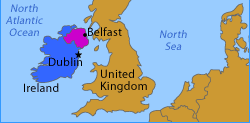Start date: 1969
Current total length: 13 miles
Official purpose: Prevention of sectarian violence
When the Republic of Ireland gained independence from Great Britain in 1921, six northern counties remained under British control and became known as Northern Ireland. While the Republic of Ireland is predominantly Catholic, Protestants hold the majority in Northern Ireland. Much of Northern Ireland’s Protestant majority is unionist (or loyalist), remaining loyal to Britain and rejecting the notion of one Ireland under Catholic-majority rule. Many Catholics in Northern Ireland are nationalists (or republicans), who seek a unified Ireland.
Decades of relative calm followed Irish independence, but in the late 1960s sectarian conflict hit the cities of Londonderry and Belfast. British troops intervened — in large part to protect the Catholic minority from abuse at the hands of the Royal Ulster Constabulary and paramilitary unionist groups — and remained; British soldiers, along with politicians and civilians, became targeted by the nationalist Irish Republican Army (IRA). The violence exploded in the 1970s, and hundreds of people, mostly civilians, were killed by unionists and nationalist alike. This period, which lasted until the 1990s, was called “The Troubles.”
In strife-torn cities such as Belfast, conflict simmered neighborhood by neighborhood and even block by block. In 1969, the British government built the first “peace line” in Belfast, in hopes of quelling violence between unionists and nationalists. Other barriers followed in the 1970s and 1980s, during the height of The Troubles. Some argue that the “Peace Line” — though not continuous, the barriers are collectively known as a single entity — is nothing of the sort; it divides communities and sows conflict. Others argue that the Peace Line has served its purpose in limiting sectarian strife, and also note that it has evolved into a part of the urban landscape; many barriers have been transformed from ugly and imposing gray steel or barbed-wire fences to aesthetically pleasing brick walls surrounded by trees and shrubs.
What is not debatable is that the Peace Line continues to expand even as political violence in Northern Ireland has dropped far below the level seen during The Troubles. The number of barriers has doubled in the past decade, and the Peace Line now covers 13 miles in Belfast. Whether residents of Belfast see the barriers as a political symbol or merely a way to avoid seeing the neighbors, many who live in its shadow appear to be fond of the Peace Line.
- Previous: Introduction
- Next: Botswana/Zimbabwe



